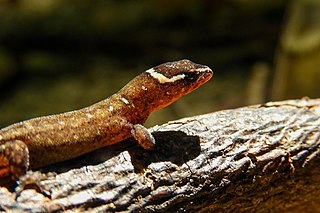
Lepidoblepharis is a genus of Central and South American dwarf geckos in the family Sphaerodactylidae, commonly known as scaly-eyed geckos.
La Venta is a fossil locality located in the modern departments of Tolima and Huila in Colombia. This site is one of the richest Neogene fossil assemblages in South America and represents the best-known Cenozoic fossil site outside of Argentina. It provides a glimpse of what life in the region was like before the main wave of the Great American Interchange.

The collared gnatwren is a species of bird in the family Polioptilidae, the gnatcatchers. It is found in Brazil, Colombia, Ecuador, French Guiana, Guyana, Peru, Suriname, and Venezuela.
The Paraguanan ground gecko is a species of lizard in the family Sphaerodactylidae.

Thylamys is a genus of opossums in the family Didelphidae. The premaxillae are rounded rather than pointed. The females lack a pouch. The females' nipples are arranged in two symmetrical rows on the abdomen. All species but T. macrurus store fat in their tails., although this is not necessarily true for all species in the genus. Fossils belonging to the genus date back to the Miocene, with the oldest specimens being found in the Cerro Azul Formation of Argentina and the Honda Group of Colombia. Genetic studies indicate that the genus may have originated around 14 million years ago.
The Laventan age is a period of geologic time within the Middle Miocene epoch of the Neogene, used more specifically within the SALMA classification in South America. It follows the Colloncuran and precedes the Mayoan age.
Lepidoblepharis buchwaldii is a species of gecko, a lizard in the family Sphaerodactylidae. The species is endemic to Ecuador.
Lepidoblepharis conolepis is a species of gecko, a lizard in the family Sphaerodactylidae. The species is endemic to Ecuador.

Lepidoblepharis duolepis is a species of gecko, a lizard in the family Sphaerodactylidae. The species is endemic to Colombia.
Lepidoblepharis grandis is a species of gecko, a lizard in the family Sphaerodactylidae. The species is endemic to Ecuador.
Lepidoblepharis intermedius is a species of gecko, a lizard in the family Sphaerodactylidae. The species is endemic to northern South America.
Lepidoblepharis microlepis is a species of gecko, a lizard in the family Sphaerodactylidae. The species is endemic to Colombia.

Lepidoblepharis miyatai is a species of gecko, a lizard in the family Sphaerodactylidae. The species is endemic to Colombia.
Lepidoblepharis peraccae is a species of gecko, a lizard in the family Sphaerodactylidae. The species is endemic to western Colombia.
Lepidoblepharis ruthveni is a species of gecko, a lizard in the family Sphaerodactylidae. The species is endemic to northwestern South America.
Lepidoblepharis sanctaemartae is a species of gecko, a lizard in the family Sphaerodactylidae. The species is found in southern Central America and northern South America.
Lepidoblepharis williamsi is a species of gecko, a lizard in the family Sphaerodactylidae. The species is endemic to Colombia.

Lepidoblepharis xanthostigma, also known as the yellow-spotted gecko is a species of gecko, a lizard in the family Sphaerodactylidae. The species is found in Central America and north-western South America.





